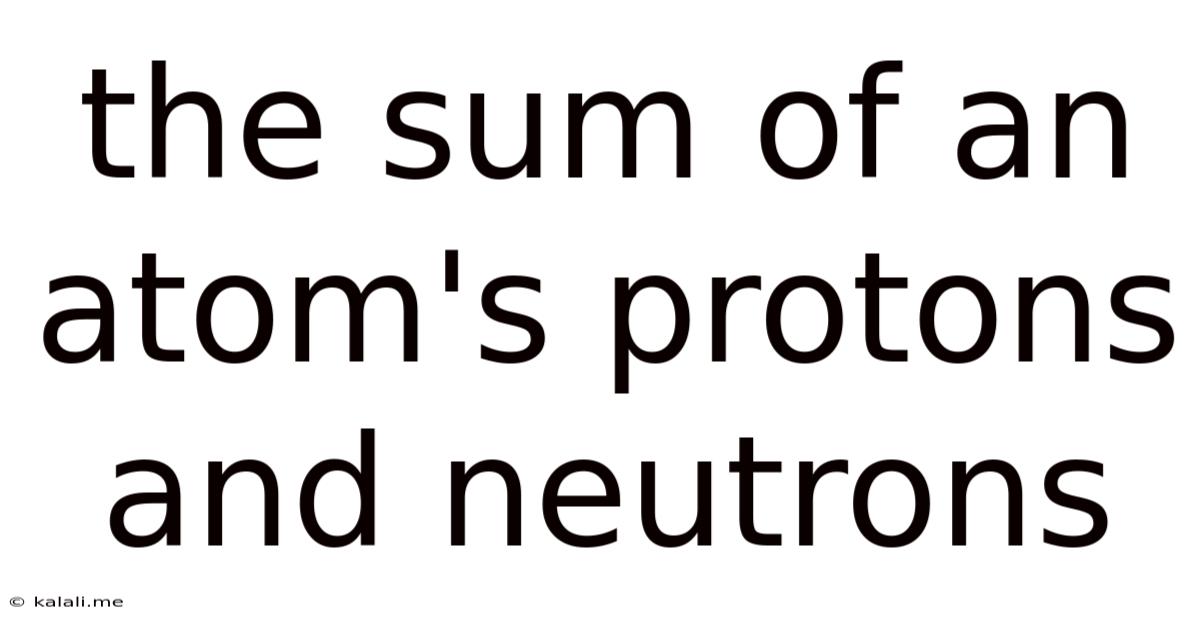The Sum Of An Atom's Protons And Neutrons
Kalali
Jun 11, 2025 · 3 min read

Table of Contents
Understanding the Sum of an Atom's Protons and Neutrons: The Atomic Mass Number
The nucleus of an atom, a tiny but incredibly dense region at the center, houses two types of subatomic particles: protons and neutrons. Understanding the sum of these particles is crucial to comprehending the fundamental properties of an element and its behavior in chemical reactions. This sum is known as the atomic mass number (also called the mass number). This article will delve into the significance of this number, its relationship to isotopes, and its applications in various fields.
This article will cover the following topics: what is the atomic mass number, how to calculate it, its relationship with isotopes, and its use in science and technology.
What is the Atomic Mass Number?
The atomic mass number represents the total number of protons and neutrons found within an atom's nucleus. It's a whole number, unlike the atomic weight which is an average taking into account the abundance of isotopes. Protons carry a positive charge, while neutrons are electrically neutral. Together, these particles contribute almost the entire mass of the atom, with electrons having negligible mass in comparison. The atomic mass number is denoted by the letter 'A'.
Calculating the Atomic Mass Number
Calculating the atomic mass number is straightforward: simply add the number of protons (atomic number, Z) and the number of neutrons (N) in the nucleus. The formula is:
A = Z + N
For instance, a carbon-12 atom has 6 protons and 6 neutrons. Therefore, its atomic mass number (A) is 6 + 6 = 12. This is why it's called carbon-12.
Isotopes and Atomic Mass Number
Isotopes are atoms of the same element that have the same number of protons (same atomic number) but differ in the number of neutrons. This difference in neutron number leads to variations in the atomic mass number. For example, carbon-12 (⁶C¹²) and carbon-14 (⁶C¹⁴) are isotopes of carbon. Both have 6 protons, but carbon-12 has 6 neutrons (A = 12), while carbon-14 has 8 neutrons (A = 14). While they exhibit similar chemical properties due to the same number of protons and electrons, their physical properties can differ due to their different masses. This difference in mass has significant implications in areas like radioactive dating.
Applications of Atomic Mass Number
The atomic mass number plays a vital role in various scientific and technological applications:
- Nuclear Chemistry: Understanding the atomic mass number is fundamental in nuclear reactions, as it helps predict the products and energy released during processes like nuclear fission and fusion. The stability of an atom's nucleus is closely tied to its mass number.
- Radioactive Dating: The different isotopes of an element, distinguished by their atomic mass number, decay at characteristic rates. This property is harnessed in radiocarbon dating and other techniques to determine the age of artifacts and geological formations.
- Mass Spectrometry: Mass spectrometry techniques rely on separating ions based on their mass-to-charge ratio. The atomic mass number is a crucial parameter in interpreting mass spectra and identifying different isotopes of an element.
- Nuclear Medicine: Isotopes with specific atomic mass numbers are used in various medical imaging and treatment procedures. For example, isotopes like Technetium-99m are commonly used in nuclear medicine scans.
Conclusion
The sum of an atom's protons and neutrons, represented by the atomic mass number, is a fundamental concept in atomic physics and chemistry. It provides valuable information about an atom's identity, its isotopic variations, and its behavior in various processes. Its applications span numerous fields, highlighting its importance in understanding the structure and properties of matter at the atomic level. Further exploration into the topic will reveal more intricate details about nuclear stability, radioactivity, and the diverse applications of this critical atomic property.
Latest Posts
Latest Posts
-
How Many Cups Are In 3 Quarts
Jul 01, 2025
-
Four Letter Word With Second Letter A
Jul 01, 2025
-
How Many 1 8 Cups Are In 2 3 Cup
Jul 01, 2025
-
How Many Slices Of Turkey In 2 Oz
Jul 01, 2025
-
Omnipoint Miami E License Llc Miami Fl
Jul 01, 2025
Related Post
Thank you for visiting our website which covers about The Sum Of An Atom's Protons And Neutrons . We hope the information provided has been useful to you. Feel free to contact us if you have any questions or need further assistance. See you next time and don't miss to bookmark.